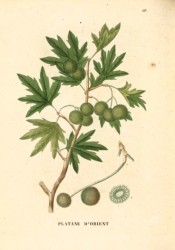Platanus orientalis L.
Fully hardy, vigorous, spreading, deciduous tree with flaking grey, brown and cream bark, deeply 5-lobed leaves, to 25cm long, and green, turning brown, fruit clusters persisting into winter. To 30m. [RHSE, Hortus, Hilliers’].
Horticultural & Botanical History
Cultivated in Britain since at least 1548. [PD]. Saint-Hilaire Arb. pl.68/1824.
History at Camden Park
Only listed in the 1857 catalogue [A.66/1857]. Possibly obtained from George Stevenson, South Australia, in 1844. [MP A2933-1, p.21]. However Macarthur included it among desiderata to Loddiges, 6th January 1845 [MP A2933-2, p.28] and to J. Abbott of Hobart on 16th June 1846 [MP A2933-2, p.159]. No longer represented in the gardens although there are two mature London plane trees on the estate, one of them at the Old Orchard, now part of the Elizabeth Macarthur Agricultural Institute.
Notes
Neither Platanus occidentalis nor Platanus orientalis are commonly planted as street trees today, they have been almost completely replaced by the hybrid London Plane Tree. ‘Gleason, H. A. The history of the London plane. Jour. New York Bot. Gard. 20: 216-220. Nov., 1919. — Largely extracts from “The history of the London plane” by A. Henry and M. G. Flood in Proceed. Royal Irish Acad. Describes in some detail history of the London plane, Platanus acerifolia, usually regarded in the United States as Platanus orientalis. Former is common street tree, has remarkable vigor, and is very resistant to smoke, drought and other unfavorable city conditions. P. orientalis is rarely planted as street tree. London plane probably a first-generation hybrid between P. orientalis and P. occidentalis, which explains its remarkable vigor and the great variability of its seedlings, part of which are similar to supposed parents, and part combine characters of both parents in various ways. Possibly originated at Oxford Botanic Garden about 1670 from chance hybridization. Experimental proof for this assumption could be obtained in the United States where adult trees of both natural species are to be found. — O. E. White.’ [Botanical Abstracts vol.4, p.90/1920].
Published Mar 24, 2009 - 04:38 PM | Last updated Mar 25, 2010 - 01:35 PM
| Family | Platanaceae |
|---|---|
| Category | |
| Region of origin | South east Europe |
| Synonyms | |
| Common Name | Oriental plane, Chennar tree |
| Name in the Camden Park Record | Platanus orientalis |
| Confidence level | high |


